Developing the Project Team
Even if you are able to assemble a 'perfect' team for your project, there is still work to be done in terms of bringing that team together. Since you are starting up a project that is new to your organization, you will need to mold the team to precisely fit what you are trying to accomplish.
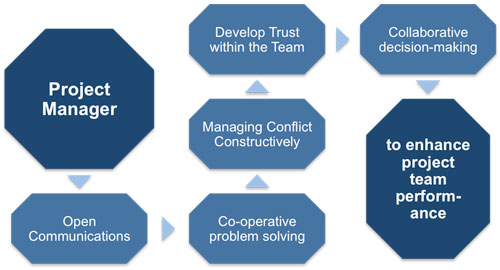 |
As project manager there are several ways you can enhance the performance of your team they are:
• Open & effective communication
• Develop trust amongst members
• Constructive management of conflicts
• Encourage collaborative problem-solving
• Encourage collaborative decision-making.
While all the skills and experiences that you need might exist within the team members, developing the team is still important to get all of them into the right roles and understanding what they are trying to do. This is especially crucial during big projects where they may be a number of smaller groups that report to their own supervisors before answering to the lead project manager.
If at all possible, the majority of the team development should take place before the project has actually started and be documented in the HR plan. You want to be able to hit the ground running within any project, but that is only possible when everyone on the team knows what their role is and what is expected of them. Ideally, the team will feel like a cohesive unit before the project is even officially underway.
Developing a climate of open and frank communication will lead to an increased sharing of ideas between team members. They are then more likely to collectively develop more effective decision-making and project control processes. One of the most influential studies in this area is Bruce Tuckman's (1965). He proposed the four-stage model called Tuckman's stages for a group, which states that the ideal group decision-making process should occur in four stages:
1. Forming
2. Storming
3. Norming
4. Performing
Tuckman maintained that these phases are all necessary and inevitable in order for the team to grow, to face up to challenges, to tackle problems, to find solutions, to plan work, and to deliver results.
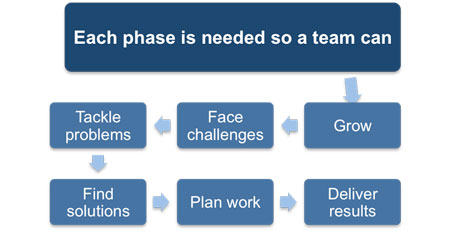 |
This model has become the basis for subsequent models and it is important to understand the process of each stage and its concepts so that you can apply it to your workplace.
Stage 1 - Forming
This first stage involves the bringing together of a group of individuals to form a team. At this stage, members usually have positive expectations about the venture, although they may harbor some anxiety about other members, such as who they are and what they are like.
At this point it is about building relationships within the group and clarifying the team's mission. Initially individuals behave independently of each other, but as they gather information and impressions about:
• Each other,
• The scope of the task,
• Its challenges and opportunities, and
• How to approach it
Each individual's behavior is driven by a desire to be accepted by the other team members and to avoid conflict. This results in serious issues being avoided, or put off, as team members concentrate on non-contentious or routine issues. This reluctance to engage in and resolve areas of conflict means that the team accomplishes very little and the underlying differences which have been brushed aside will eventually surface and have to be addressed.
The length of this first stage will depend on how clearly the task is defined and on how much experience the individuals have of working in a team. Groups with simple tasks will move through orientation quickly, but groups with complex goals and tasks may spend much longer in this stage.
Teams made up of people who are used to being autonomous will take longer to build the necessary relationships for a successful team than those used to working in a group. Many individuals may be reluctant to contribute at this stage and their support of the leader is given cautiously
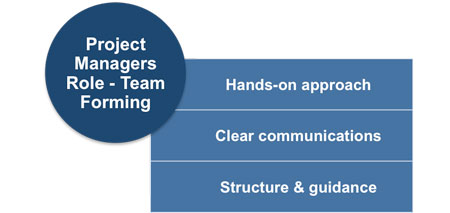 |
As a project manager you need to be very 'hands on' at this stage, giving clear directions and structure to make sure that your team build strong relationships. You can facilitate this by making sure your communications dispel any misunderstandings that could arise about roles and responsibilities.
With decisions being made in the majority of cases by the nominated leader you also need to ensure that no team member is committing themselves to do too much, or too little, of the planned work. By paying attention from the outset to building good relationships, as well as focusing on a clearly defined task, your team will perform better than teams whose project managers rush through or skip over the relationship-building stage.
Stage 2 - Storming
During this second stage, where team members feel more able to express and question opinions, you will see more evidence of internal conflict. Your role as project manager is to contain and direct this energy into a productive channel. You need to be aware that some level of internal conflict will cause a simultaneous dip in team morale.
Your management role will have to become more supportive, guiding the team in their decision-making and offering explanations of how these decisions came about. You need to define what you and the organization expect of the team in terms of professional behavior.
This more instructional approach will enable you, as project manager, to prevent any conflict from getting out of control and poisoning relationships between team members.
You will be able to recognize when your team moves into the 'storming' stage because you will observe them beginning to address the differences between their initial perceptions and the reality of the situation that they have been formed to address. This will cover issues such as:
• What problems they are really supposed to solve
• How they will function independently and together
• What leadership model they will accept.
As your team members begin to negotiate the work assignments and express their views on the best way to achieve the task outcome disagreements will arise. Through your active listening skills you will mediate and help decisions to be made through compromise as the most efficient way to attain the necessary outcomes. To learn more about this communications skill, download the free 'Active Listening' eBook from this website.
While your team members confront each other's ideas, test differing perspectives, discuss what the group needs to do, and how best to accomplish it, your role becomes one of a facilitator building trust within sub-groups of the team.
Team storming, whilst it may be contentious and unpleasant, will be resolved relatively quickly with your guidance and support. You must view this as a necessary step for your team to become a cohesive whole, not as an enormous irritation to be dismissed.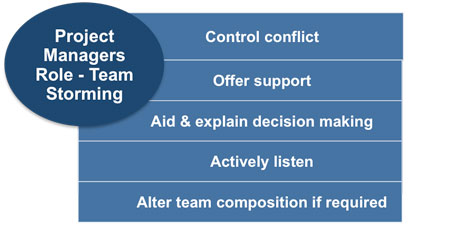 |
As a manager you need to be mindful of how this 'conflict' affects your team members and coach them in developing their own coping strategies. For example, some individuals may:
• Find this stage painful because they are averse to conflict.
• Feel anger or frustration with the task, or with other members.
• Resent the presence of formal leadership.
• Focus on minutiae to avoid the real issues confronting the team.
The maturity in terms of attitude and approach to problem resolution of some team members can be significant in determining whether your team will ever move out of this stage. If you try to bulldoze through this stage in your team's development you may find it becomes a permanent state, resulting in low morale and lack of productivity.
If you fear this is happening to your team you will need to see how much flexibility you have in altering the composition of your team within the constraints of your organization.
You may choose to break the team into smaller subsets of cohesive individuals within your team so that morale and productivity are raised.
Stage 3 - Norming
Once your team has reached the third stage of its development the members focus on resolving differences so that the mission and goals can be clearly defined. Your role within the team transfers from that of leader to that of team member.
Team members are learning more about each other and how they will work together and are developing tools such as a:
• Problem-solving process
• Code of conduct
• Set of team values
• Measurement indicators.
The team has now established core processes, and as manager you need to ensure the team avoids spending unnecessary time on issues related to the smaller processes.
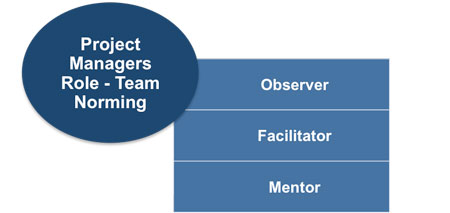 |
During this period of negotiation and discussion, your role becomes one of observer and facilitator in order to assist your team in establishing the ground rules of behavior as they learn to work together. Their attitudes are characterized by:
• Decreasing animosities toward other members
• Feelings of cohesion, mutual respect, harmony, and trust
• A feeling of pleasure in accomplishing tasks.
Your team is truly developing a sense of team pride, and you will see evidence of increased productivity as skills develop. The team arrive at decisions that are more in line with their purpose rather than from a position of compromise. You can begin to transform your role as coach to one of a mentor and delegator, offering your team greater opportunities to raise their levels of expertise.
Stage 4 - Performing
Now your team has reached the final stage of its development and can now bring real benefits to you and the organization. Your team members are now competent, autonomous, and able to handle the decision-making process without supervision.
Your team has been accomplishing work at every stage, but it is at this 'performing' stage that work is accomplished most effectively. Morale is high and the general atmosphere is positive. Team members' attitudes are characterized by positive feelings and eagerness to be part of the team.
Members are confident about the outcome, enjoy open communication, exhibit high energy, and disagreement is expected and allowed as long as it is channelled through means acceptable to the team. Leadership within the team is often shared and tasks are delegated within the team, which makes the overall decision-making process operate more easily than at earlier stages.
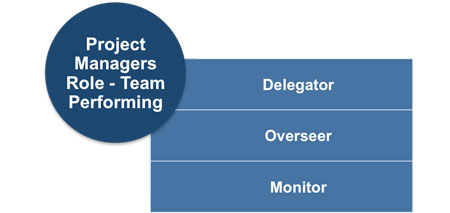 |
As a project manager, once your team is operating at this level then your role becomes one of overseer and delegator. You are no longer involved in day-to-day activities and the team's relationships with each other emulate the high degree of trust and loyalty you show in your relationship with the team.
Another key task you will perform at this stage is one of monitoring your team's relationships and performance to ensure that the group dynamics remain positive and productive. This is because changes in the dynamics of the group can result in high-performing teams reverting to earlier team-building stages.
For example, a change in leadership may cause the team to revert to 'storming' as the new people challenge the existing norms and dynamics of the team. To read more about other team development models download the Team Development eBook from this website.
Generally speaking behavioral guidelines are more important when the project team is being drawn from diverse backgrounds that have different behavioral norms. Early commitment to clear guidelines decreases misunderstandings and increases productivity. All project team members share responsibility for enforcing the rules once they are established.
The benefits of locating as many of the project team members as possible in the same place are twofold:
Firstly, it makes communication easier in terms of face-to-face meetings.
Secondly, it engenders a sense of team identity that is difficult to develop when people cannot socially interact with each other.
Recognizing and rewarding desirable behavior is an important part of successful team building. For example, working overtime to meet tight deadlines or helping another team members to develop their skills are things that should not be taken for granted by the project manager. People are motivated if they feel they are valued in the organization and this value is demonstrated by the rewards given to them.
In most cases, the project manager will not have the authority or funding to give out monetary rewards. In today's rapidly changing business environment people are more aware than ever of their market value and this means that there are rewards that can enhance a team member's professional reputation and their future prospects for promotion.
The opportunity to gain new skills can add long-term earning potential and in many cases will represent a more significant reward in monetary terms than a one-off cash bonus. Where a training course has already been commissioned it is usually possible to offer additional places on it at minimal cost to the project and this can represent a high-value reward particularly to freelancers who tend to be more aware of their future marketability than permanent staff.
Similarly, giving someone more responsibility can be seen as a reward provided that it is done in a way that will benefit him or her in the longer term. For example, changing someone's role description from 'Expert User' to 'Senior Expert User' explicitly acknowledges that they have taken on more responsibility and is something that they can use to enhance their resume.
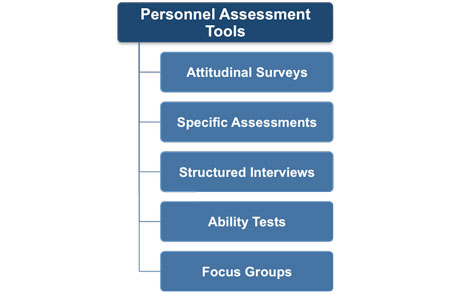 |
Various tools are available such as attitudinal surveys, specific assessments, structured interviews, ability tests, and focus groups. These tools give the project manager and the project team insight into areas of strength and weakness. They help project managers assess the team preferences, aspirations, how they process and organize information, how they tend to make decisions, and how they prefer to interact with people.
The criteria by which performance will be assessed should be objective and based on agreed project objectives wherever possible. However, this needs to be tempered with a certain amount of subjective judgment. For example, in hindsight were the objectives realistic?
Another point worth making is that the project team must be encouraged to take a wider view of things. They must not become target focused at the expense of alienating people outside of their immediate group, whether this is other in-project groups, departments within the organization or third parties like customers and suppliers.
The evaluation of a team's effectiveness may include indicators such as:
• Improvements in skills that allow individuals to perform assignments more effectively,
• Improvements in competencies that help the team perform better as a team,
• Reduced staff turnover rate, and
• Increased team cohesiveness where team members share information and experiences openly and help each other to improve the overall project performance.
 |
These performance assessments may suggest specific training is needed or that changes are required within the project organization. This information needs to be reflected back into the organization so that these new enhanced skills can provides increased benefits for future projects or operational work by the individuals concerned.
You may also be interested in:
Managing a Project Team | Developing the Project HR Plan | Building an Effective Project Team | Developing the Project Team | Dealing with Conflict in the Project Team | Planning Project Communications | Optimizing Project Communications | Managing Project Communications | Identifying Project Stakeholders | Keeping Project Stakeholders Informed.
|
|


